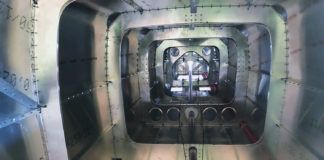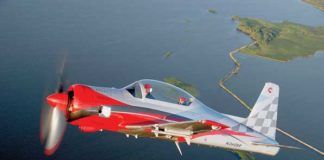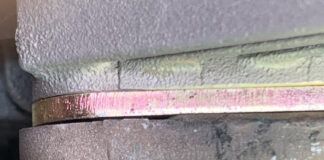Last month I promised no monsters would intrude upon the serenity of building. A couple of minor gremlins waltzed through, but they were sent scurrying as nothing more than trivial annoyances. Maybe my expectations have changed?
So there the Jabiru sits. Horizontal tail planes are in place, and it’s on three wheels with one sawhorse under the tail and three 5-gallon gas cans suspended from the nosewheel mount as a counterbalance.
This airplane is not supposed to be a taildragger, so let’s get the nosewheel on the ground by adding a bit of a counterweight. There’s a dandy piece of aluminum under the shelf, so we’ll use it.
This was one of the reasons I bought this airplane; it has the most drop-dead beautiful engine you could ask for. The crankcase is two pieces machined from solid aluminum, which are bolted together and then given a completely unneeded pass with a fly-cutter. The result is a beautiful pattern of crescents along the upper surface, making the parting line between the cases almost, but not quite, invisible. Artwork.
The cylinder fins are also machined, not cast. The advantage here is not just beauty; it helps the cooling. Cast fins have to be tapered so the mold will release the part. That makes them thicker at the base than at the outer edge, so the fin has a higher volume/surface area ratio.
Let me explain: Heat up a thin hunk of metal to the same temperature as a thick hunk. Which one cools off first? Yep, the thin one, because the heat contained in the material is close to the surface.
“Hey wadeaminut!” you’re saying. “This engine has a reputation for running a bit hot.” As the Aussies would say, “S’truth, mate.” I think I know why, and I’ll be explaining the reasoning plus, I hope, offering a solution later.
But no matter what, this fin design helps the cooling and looks great. The only thing needed is a transparent cowl…seems a shame to hide it.
Hanging the engine turned out to be easy. The factory instructions came through and suggested putting the mount onto the engine and then lifting the mount/engine into place. That’s a heck of a good technique.
The engine/mount interface is cushioned in a sandwich of beefy rubber bushings topped with nicely machined aluminum caps, covered with self-centering spacers and pierced through with genuine AN bolts. If it were a lunch menu item, I could have eaten it, it looked so good.
Drilling for the Mount
Before that all goes together, though, you need to drill the holes in the firewall. Oops! Applying the stainless-steel shield covered up the eighth-inch holes that Jabiru had drilled in the wood. You can see them from the cabin side, and it sure would be nice to be able to check their location before enlarging and drilling through the stainless steel. Forget trying to use the mount from the inside; even if you could put it up there, there’s no purpose, as it would be reversed!
All I could do is measure the bolt pattern on the mount, compare it to the holes that I could see, hope it was correct, and run a drill through from the cabin side. It worked! They were dead on target, so I enlarged them and did a fit-up of the mount by itself to assure that all the bolts fit smoothly.
What I should have done, and you should if you’re building a Jabiru, is to check the position of the firewall holes before you put that stainless-steel firewall plate in place. The holes in the wood are about an eighth-inch in diameter, so put some bolts through the wood from the cabin side and then hold the engine mount up to them. The engine mount uses larger bolts, so you might need some help to hold all of it in place while you check that everything is properly centered.
I was lucky and in hindsight I probably should have played it safe by making a transfer punch. You home machinists out there can easily make one on a lathe. Cut a steel shaft such that it’s a smooth fit through the engine mount, and then cut a nice point on one end. Drill through one of the existing wood holes and then through the stainless steel. Now hang the mount from that first hole and position it to level. One person holds the mount in place, and the other puts a punch mark on the firewall. Drill that second hole out to the size of your bolt, and hang the mount from the bolt. With the mount now stable, you can punch all the remaining holes in one go.
Using a transfer punch is preferable to just using a drill through the mount if for no other reason than it’s tough to keep the mount in position while pushing hard enough to start a 3⁄8-inch drill in stainless steel. Jabiru did it exactly right, and I didn’t have to resort to the transfer punch.
But Before That…
Throughout this series, I have related how important it is to think ahead. Right here is a good instance of the truth of that advice. I’m going to have to mount the airbox on the firewall, and it’s going to be a lot easier to drill the stainless without the engine in place. The instructions did say to do this, so I can’t claim prescience.
It’s a simple job, but an interesting component because the airbox itself is so well made. It left me puzzled about the quality systems at Jabiru. Why are the parts so inconsistent? The wingtips are atrocious, and the composite airbox is perfect? Whoever builds that part ought to be let loose on the rest of the airplane, I say.
Have the mount held in place with a couple of bolts so you can position the airbox. While you’re at it, now is a good time to lay out where you want the starter solenoid and the voltage regulator. I put the regulator up there with the mount in place and found that I had to reposition it later. There’s enough room for positioning these items, so be sure to just space them away from one another.
Having assured myself that the mount would fit the firewall, I could now reassemble the mount to the engine and hang the whole thing out there. I’ve loaded fuel in nuclear reactors and designed cutting-edge equipment for Silicon Valley, but this was just plain fun that made those experiences seem inconsequential.
My buddy Buzz had brought his engine hoist over, so we attached the mount to the engine and lifted it all up into place. Easy. Except the crankshaft is pointing up at about 3°! “Let it sit/settle/sag,” said Buzz. I did, but it didn’t. A preliminary fit of the cowl showed that something was askew.
After letting it sit for a couple of weeks, I decided to remove those shims between the engine and mount and remeasured it all. A quick fit of the un-cut cowl showed that the crank would now exit roughly in the center of the cowl. I’m going to have to assume that the aft end is off-center though. If it is not I can plan on adding a big fin to the rudder. Remember P-factor? That’s the asymmetric loading on the prop as the angle of attack increases. The prop is a big gyroscope, so if an unbalanced force is applied to one side of the disc, the reaction is 90° away; in this case it causes a yaw. Also, keep in mind the corkscrew airflow around the fuselage at low airspeeds and high prop thrust, such as during takeoff. It hits the side of the rudder, so a bit of opposite angling of the engine can help.
Did I get it right? Shortly after deciding to remove the shims I received a third set of instructions in a PDF format. There are no shims. Those lads Down Under are getting this part straightened out, but only the first flight will tell if it’s really perfect. Fortunately, it’s easy to adjust in this design.
Muffler Snakes
Here’s where I get to the 90% complete, 90% to go point by fitting the exhaust. I was mentally prepared to spend a lot of time trying to get it all to fit. Six exhaust stacks going into a single muffler would seem a job akin to stuffing mad snakes into a garbage bag. But it turned out to be really easy! Loosening just one pair of bolts on an exhaust pipe was all it took to get all six pipes into the muffler. Jabiru seems to have this thing for working in metal. It’s pretty, it fits, and it’s a pleasure to work with.
The muffler is held in place with four springs, not six. At first I thought they’d omitted one on each pipe, but a closer look revealed that somebody at the factory was really thinking. These are not particularly high-tension springs. Still, you’ll be tempted to grab the free end with Vise-Grips. In a word, don’t. A spring is a carefully heat-treated device that’s extremely sensitive to crack propagation. If you put a small scratch in it, it is likely to break. There are soft-jaw pliers specifically for this purpose, but lacking them, you can use a small screwdriver inserted through the spring loop to pull the spring into position.
Having done that I still put a safety wire through the center of each spring. It was then tied off to each mounting point with a bit of slack. If the spring were to break, the pieces are retained, and the pipe is held in position.
Speaking Strine
Winston Churchill once commented that, “England and America are separated only by a common language.” The truth of that was evident when I told a neighbor that I was “offering up” the “muff” as I wanted “carby heat” when descending. S’truth, mate!
I was also going over the latest set of instructions and have to say that Jabiru has done a good job of it. There’s still a bit of Strine scattered about, but this project would have been a lot easier if I’d had this version at the start. For instance, there are two fiberglass wedges in the kit. Each is about an inch wide, 4 inches long and tapers from a quarter-inch down to zero. I’ve looked at these innumerable times, but only on reading this new set of instructions did I learn where they go.
The bad news is that as I write this, the new instructions are still incomplete; they only go as far as fitting the ailerons. But Jabiru is fixing the documentation problem. Keep up the good work!
Build the Record as You Build
I’ll wrap up with a generic tip: Keep good records. With the recent problems caused by builders receiving more than just a little help, you should be fairly meticulous in your record keeping. Paper is so passé that I dragged an old 486 computer and a cheap flat-panel monitor out of the closet and made a quick, stand-up desk in the shop. I’d won a copy of Kitlog Pro at a club raffle, so logging has been done on it throughout this build.
Kitlog is software designed for kit aircraft builders that allows you to rattle on as you care to as you create your masterpiece. Three photos can be added to each data entry, and your time is nicely added up as well. You could use a lot of other methods, but I’ve found this to be rather easy and would recommend it (You can find out more about this software at www.kitlog.com.)
Having said that, I’d best go to work so I have something to log for next month’s installment.
For more information on the Jabiru J250, call 559/431-1701, or visit www.jabirupacific.com.













